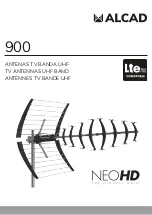
Geophysical Survey Systems, Inc.
GS Series
200 HS Antenna
MN27-151 Rev A
11
Soil Type:
This option is only visible if the vertical scale is set to depth. Soil type allows you to rapidly
change the dielectric to one of the preset described values. Choose the one which most closely matches
your survey conditions.
Depth:
This option is only visible if the vertical scale is set to depth. Changing depth will change your
depth of investigation by changing the time range (hidden). Remember that depth accuracy is dependent
on correctly setting the dielectric value.
Surface (%):
Surface (%) refers to the position of the viewable scan with respect to the antenna’s direct
wave. The direct wave is the first instance of the receiver seeing the transmitted signal and corresponds to
the ground surface. There may be situations when you want to view a portion of the scan before the direct
wave. Shifting the surface % in the negative direction will move the direct wave farther down the
window. The value here is the percentage of the full time range, so a surface % of -10 and a range of 100
will shift the scan by 10 ns.
Samples/Scan:
Each scan trace is made up of individual samples. You can think of samples as the
“dots” that make up a “line.” Samples are digitized from the small bursts of reflected energy which return
to the receiver. The amount of samples/scan can affect your vertical resolution. Too few samples risks
recording a signal with too low resolution but too many will result in slower collection and larger files
sizes for no practical benefit. For a 200 MHz antenna a good rule of thumb is to multiple your time range
by 10 and then divide by 2.5. Set your sample density to the next step higher than the result.
Scans/Second:
Refers to the maximum number of scans each second that are available to record. This
value is the functional limit of your collection speed and should be set as high as possible. It will vary
according to the interplay of your samples/scan and transmit rate.
Scans/Point:
This option is only visible if the collect mode is set to point. This parameter controls the
number of scans collected and averaged into a single recorded scan at each given shot location. The
higher the number, the more averaging that takes place. More averaging, if subsurface conditions permit,
may result in deeper penetration.
Filter
This section contains controls for different horizontal and
vertical filters used to clean up your data and remove
noise. All of these are for display only and their use does
not permanently alter your collected data. The results of
these filters are stored in the DZX file which is parsed by
RADAN when you display your data file in the software.
RADAN will apply the settings you have input during
collection and then you can decide whether to keep the
output or manually process with different settings.
Low Pass / High Pass IIR (MHz):
These frequency filters
are designed to help remove artificial radio noise from
your data. The HS technology is already very effective at
removing noise, but these filters can assist. IIR stands for
infinite impulse response. It is a method of filtering in signal processing. Think of these as book ends. The
low pass (LP) is the higher of the two values and passes all frequencies which are lower than a specified
cutoff frequency. The high pass (HP) does the same for frequencies higher than the cutoff. You can
experiment with these to isolate areas of the recorded frequency spectrum. In general, you do not want to
set the filter so that it cuts off the antenna’s center frequency. For example, you would typically not set
the LP filter lower than 200 MHz because you would be removing actual antenna signal. Good values
here are 2-3 times the center frequency for the LP and ¼ - 1/3 the center frequency for the HP.
Содержание 200 HS
Страница 1: ...MN27 151 Rev A ...
Страница 4: ...Geophysical Survey Systems Inc GS Series 200 HS Antenna ...
Страница 6: ...Geophysical Survey Systems Inc GS Series 200 HS Antenna ...
Страница 32: ...Geophysical Survey Systems Inc GS Series 200 HS Antenna MN27 151 Rev A 26 ...
Страница 33: ...Geophysical Survey Systems Inc GS Series 200 HS Antenna Notes ...
Страница 34: ......
Страница 35: ......
















































